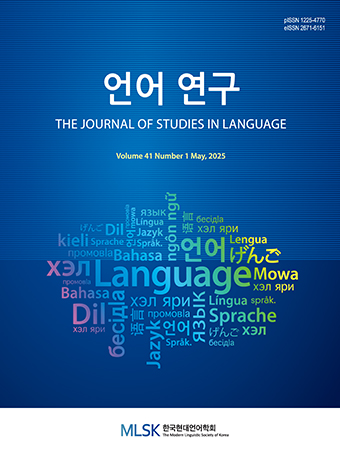Research Article
Abstract
References
Information
A Comparative Study on the Perceptions of Korean High School Students and Teachers about Asynchronous Online English Classes. The purpose of this study is to compare the perceptions of students and teachers about the current online English teaching and learning since the outbreak of COVID-19. For this study, questionnaires have been used for 513 students and 10 teachers of a girls’ high school located in “D” city, South Korea. The results are as follows: First, there were no significant differences in student and teacher perceptions depending on the subcategories of online English learning. Second, both groups showed the average level of satisfaction with online English classes. Third, both groups showed the necessity for encouraging interaction among class participants. Considering the results above, interaction among class participants should be encouraged by either implementing synchronous mode of class or any other way. This research was based solely on the asynchronous mode of online education with class video contents, so it was not able to comprise other varieties of online learning.
- 교육부. 2020a. 코로나-19 감염병 대응 2020학년도 초․중․고․특수학교 원격수업 운영 기준안. 세종: 교육부.
- 교육부. 2020b. 3. 31. 처음으로 초, 중, 고, 특 신학기 온라인 개학 실시. 보도자료. 세종: 교육부.
- 교육부. 2020c. 5. 8. 원격교육 실태조사. 원격교육정책자문단 자료. 세종: 교육부.
- 권성연. 2020. 코로나19에 따른 초중등 교사들의 온라인 수업 경험과 인식에 대한 탐색. 『교육공학연구』 36, 745-774. 10.17232/KSET.36.3.745
- 김양희, 신유선, 정영경. 2020. 비대면 온라인 영어수업 운영에 대한 영어과 학생 교사들의 인식 조사. 『언어과학』 27.4, 1-24. 10.14384/kals.2020.27.4.001
- 김진숙. 2020. 코로나19 대응 원격교육 성과와 과제: 글로벌 에듀테크 생태계 구성 가능성 탐색. 『한국IT서비스학회 2020년 춘계학술대회』, 462-471.
- 박선호. 2020. 코로나19 시대 온라인 수업에 대한 초등영어교사들의 인식과 평가. 『응용언어학』 36.4, 183-212. 10.17154/kjal.2020.12.36.4.183
- 박현정. 2020. 온라인으로 진행된 초등학교 정규 영어 수업에 대한 학습자의 만족도 분석. 가천대학교 교육대학원 석사학위논문.
- 박현정, 정선주. 2020. 온라인 초등학교 정규 영어 수업에 대한 학습자의 만족도 분석. 『Multimedia-Assisted Language Learning』 23.3, 339-358.
- 배철웅. 2020. 원어민 영어보조교사의 온라인 수업과 오프라인 수업에 대한 한국 중학생들의 인식조사. 『한국교육』 47.3, 91-118.
- 오지수. 2020. 원격수업에서 초등 영어교사들이 겪는 어려움과 개선 방안. 경인교육대학교 교육전문대학원 석사학위논문.
- 이동주, Misook Kim. 2020. 코로나 19 상황에서의 대학 온라인 원격교육 실태와 개선방안. 『Multimedia-Assisted Language Learning』 23(3), 359-377.
- 이쌍철, 김정아. 2018. 학생의 온라인수업 만족에 영향을 주는 요인 분석. 『교육행정학연구』 36.2, 115-138.
- 장혜승. 2020. 포스트 코로나 시대의 변화와 전망 - 초중등 단계의 원격수업을 중심으로. 『The HRD Review』 23.3, 96-119.
- 정양수. 2015. 온라인 영어학습에서 학습자의 만족도에 영향을 미치는 요인 분석. 『언어학 연구』 34, 325-347.
- 정지윤. 2021. 콘텐츠 활용형 온라인 영어 수업에 대한 초등학생과 학부모의 인식 및 태도 연구. 한국외국어대학교 교육대학원 석사학위논문.
- 최가영, 윤택남. 2020. 온라인 초등영어 수업의 방향: 온라인 영어 수업에 관한 초등학습자들의 인식도 조사. 『한국초등교육』 31.4, 145-160.
- 최원경. 2020. 코로나19 사태에서 온라인 영어 수업에 대한 초등학생 및 학부모 인식 조사: 실시간 대 비실시간 수업 비교. 『초등영어교육』 26.4, 115-136.
- 최윤정, 지난영. 2020. 비대면 영어 수업에서 상호작용과 수업 만족도와의 관계 연구: 수업 방식의 조절 효과를 중심으로. 『Multimedia-Assisted Language Learning』 23.4, 233-253.
- Bae, C. W. 2020. Investigating Student Satisfaction with Distance Learning and Influencing Factors: A Case of Korean EFL Middle School Students. Modern English Education 21.4, 36-44. 10.18095/meeso.2020.21.4.36
- Bandura, A. 1997. Self-efficacy: Toward a Unifying Theory of Behavioral Change. Psychological Review 84.2, 191-215. 10.1037/0033-295X.84.2.191 847061 PMC4010856
- Chiasson, K., Terras, K., and Smart, K. 2015. Faculty Perceptions of Moving a Face-to-Face Course to Online Instruction. Journal of College Teaching & Learning (TLC) 12.3, 321-240. 10.19030/tlc.v12i3.9315
- Palmer, S. R. and Holt, D. M. 2009. Examining Student Satisfaction with Wholly Online Learning. Journal of Computer Assisted Learning 25.2, 101-113. 10.1111/j.1365-2729.2008.00294.x
- Sheridan, K. and Kelly, M. A. 2010. The Indicators of Instructor Presence that are Important to Students in Online Courses. Journal of Online Learning and Teaching 6.4, 767-779.
- Publisher :The Modern Linguistic Society of Korea
- Publisher(Ko) :한국현대언어학회
- Journal Title :The Journal of Studies in Language
- Journal Title(Ko) :언어연구
- Volume : 37
- No :2
- Pages :181-196
- DOI :https://doi.org/10.18627/jslg.37.2.202108.181




 The Journal of Studies in Language
The Journal of Studies in Language






